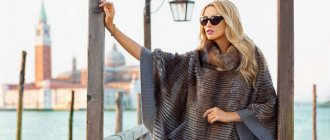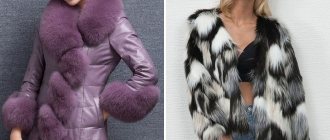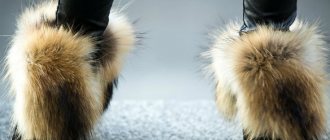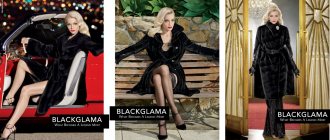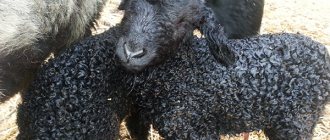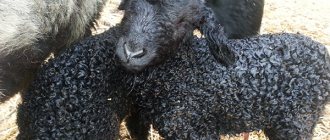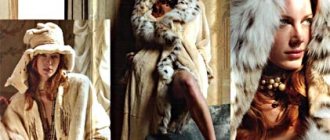Previously, mostly wealthy people could afford a good fur coat. Today, the assortment of winter clothing has expanded significantly and has become more accessible due to the emergence of new, still unfamiliar to a wide range of buyers, fur products called orylag
. What kind of fur is this and what its advantage is, we will tell you below.
Orylag chinchilla: what is it?
Orylag - rabbit
, which was bred by French breeders from the best representatives of the
Rex
. It belongs to the hare family, chinchilla order, and is the youngest species created in the last century.
The French government allocated huge amounts of money for these developments. The scientists' task was to breed an animal whose fur would be as dense and silky as that of a chinchilla, but the size of the skin would be much larger. It took 15 years of painstaking work to obtain the necessary results, but the expectations and costs were justified. The final material turned out to be warm, durable, and easy to use.
Today there are three shades of Orylag:
- “Chinchilla” – light gray in color.
- “Ash Gray” is an ashy shade.
- "Beaver" - brown.
The demand for outerwear made from orylag is growing steadily. But despite this, rabbits are still raised in only 25 farms. The process is strictly controlled by the French government, since Orilag is a national treasure and the pride of the French.
Other breeds of furry rabbits
Crossing with other rabbit breeds allows you to experiment with fur colors.
Rabbits are divided into the following types:
| Name | Peculiarities |
| Angora | Individuals with the longest hair - up to 25 centimeters. Feels like silk. Used to make yarn |
| Rex chinchilla | The most valuable fur. Velvety dense wool |
| Rex marder | Imitates marten fur |
| Flanders | The skins are dyed to resemble the fur of lynx and chinchilla |
| Castor rex | The color and hair of the animal are similar to a beaver |
Dwarf and downy rabbits are widespread. Animals are raised for their fur, with periodic trimming.
Advantages and disadvantages
The result of the work of French breeders truly exceeded all expectations. What is this?
- Orylag is superior to chinchilla in terms of wear resistance.
- The structure of the hair allows products to be dyed in various colors, and it does not lose its shine and silkiness over time.
- Thin hairs create a dense layer of fur due to the fact that they sit very closely to each other. This makes the fur coat warm, not windy, but not heavy. Since the thickness of one hair is only 15 microns.
- Orylag rabbit skins are soft and elastic. Thanks to these qualities, they are easy to process, which allows designers to open new horizons when sewing and designing products.
Orylag has only one drawback: it is produced in small quantities in order to fully satisfy the growing needs of producers and consumers. Therefore, the price is not always as low as it could be. However, it is still less than that of chinchilla products, given the practicality and wearability of such a fur coat.
Characteristic
Chinchilla rabbits have a stocky build. Some adults are fattened up to 7-8 kg. Such large sizes are obtained precisely due to the strong skeletal system of individuals. An adult rabbit can be up to 65 cm in length, and the sternum girth is about 40 cm. The head looks small in comparison with the body, and the ears are usually erect.
The dominant fur color of the chinchilla is silver-blue. The belly, tail and paws are lighter. In general, the entire color is uneven, called zonal. However, the transitions are very beautiful and attractive in appearance. The fur itself is thick and uniform.
Taking into account the characteristics and description, domestic rabbit breeders began to breed the subspecies as a meat-skin type. Although initially the breed was bred by breeders as a skin breed. The fur of individuals is indeed better than that of ordinary subspecies. Chinchillas are successfully purchased by companies that produce fur.
At the same time, the skins are used in natural colors, which is even considered a solid and more expensive option in comparison with tinted products.
How to choose a fur coat from orylag?
Nowadays, many dishonest sellers sell the Rex, passing it off as a French orylag. This is due to the high demand for the product and its low availability in stores. How to avoid mistakes in identifying a fake
?
Here are some tips:
- If the seller persistently proves to you that this fur coat is made of orylag, but not from French, but from American or some other material, do not believe it. This type of chinchilla is bred only in France and relatively recently. Therefore, they are generally a rare guest in our stores.
- So far there are two types of colors: brown-red and light gray chinchilla. Everything else is unlikely to be natural orylag.
- The color of a rex dyed to resemble a chinchilla will be bright. The stripes are clear and expressive. In natural chinchilla orylag, the pattern will be paler, uneven and asymmetrical in places.
- The strips of origal skins from which the fur coat is made cannot exceed 30-33 centimeters from seam to seam. If it is a Rex, the pieces are made longer - 40 centimeters.
- There should be no pungent odor.
- And of course the price for Orylag will be higher than for Rex.
You need to carefully choose the product on which you are going to spend an impressive amount of money. So don’t be shy: touch, look, ask.
Content
Chinchillas were bred as unpretentious animals, so they are not particularly demanding in terms of living conditions. There are certain rules:
- The animal needs clean cages , so the bedding should be changed daily;
- nutrition should be regular and balanced;
- clean water is needed , which must be heated in winter;
- direct rays of the sun should not fall on the cells;
- winds and drafts are unacceptable, but the room should not be stuffy;
- Protection from rodents is important - they transmit infectious diseases to animals.
Housing
The main home for chinchillas is cages, which are placed outside in the summer, where they are well ventilated. For young animals, livestock breeders set up separate pens in which the animals can run and frolic. It is believed that animal activity affects fertility and immunity. In order for it to survive in the winter, the cages must be insulated and the pets must be kept at a temperature not lower than +14.18 degrees Celsius.
For better insulation, two-tier placement of houses is allowed. It is also called shade and implies individuality when constructing schemes.
In any case, keeping shads saves space and, according to reviews from breeders, increases farm productivity.
Pets are kept separately from each other, which eliminates the transmission of infections. Two compartments are only possible in a rabbit house. The stern and maternity parts are connected to each other by a mink. For ease of maintenance, the cage should have two doors. The main disadvantage of keeping shads is the need for heating in winter.
Furry pets bred for industrial fur should not be kept in minks. The fur suffers greatly from the pitting method, and the animal itself does not feel the best.
Cells are purchased ready-made or made independently from scrap materials. Acceptable dimensions are 40x70x60 cm. The bottom is allowed to be slatted, the top and sides are made of plywood, the front part is made of metal mesh.
Nutrition
The diet is selected depending on the time of year. For example, in summer you can give dried seeded or meadow grass. The diet should also contain grains and feed. Animals will not refuse to chew the bark. Whenever possible, farmers add skim milk or whey to the drink. A good supplement would be various vitamin and mineral feeds.
The animal needs bone meal and chalk, but they can be present in the diet in small quantities. Fresh drink is an essential part of any rabbit’s diet, since without water they do not digest food well. In the summer, when there are juicy root vegetables, you may drink less. Feeding should be twice a day, with a break of 12 hours. Overfeeding can cause obesity in animals.
Any food for rabbits must be fresh. Foods that are frozen, moldy or rotten are not suitable for food.
The diet may contain tree branches, which are considered beneficial for the teeth of animals.
Hygiene
Clean cages are one of the main conditions for successful breeding of pets. The optimal cleaning time is 3 times a week. A one-time general cleaning with disinfectants is required. It is recommended to secure feeders and drinkers well. Fluffy animals are active, so they can spill drink or scatter food. Inedible leftovers will have to be thrown away, and this is an unnecessary cost overrun.
Drinkers and feeders also need to be thoroughly washed to prevent bacteria from developing in them.
Walk
Walking pets in winter, in cold weather, is allowed in regions with low temperatures. Here livestock breeders keep animals, even in freezing conditions, only outside. The breed advantage of chinchillas is their valuable thick fur, which protects them in cold weather. In order for the animal not to die, but at the same time to feel good, it is necessary to increase the calorie content of the diet. The value of chinchillas' thick winter fur is very high.
Storing and caring for Rex rabbit fur
A good thing must be properly stored and carefully looked after. We'll tell you how to do this.
- If you happen to get wet in the rain, and in our region this happens in winter, do not try to dry your fur coat on a radiator, with a hairdryer or other devices. Hang it on a hanger and that's it. It will dry out on its own.
- After the clothes have dried, comb the pile in its direction.
- You can’t even sew on a button here just like that. Place a piece of fabric, or preferably leather, under it. It will prevent the lining from spreading.
- Do not carry heavy bags, much less backpacks. They will leave scuff marks that cannot be corrected.
- If the fur coat is light, it must be stored in a dark bag or bag. Otherwise it will turn yellow.
Do not try to remove difficult stains yourself; take them to the dry cleaner. dry cleaning must be carried out once a year before storage.
Anyway.
Productivity of the Soviet chinchilla
Initially, the breed was conceived as a skin breed, and meat characteristics came as an additional bonus. However, in practice, breeding chinchilla rabbits pursues both goals - obtaining both meat and skins.
The quality of the fur of the Soviet chinchilla is on average one and a half to two times better than that of ordinary rabbits. For this reason, chinchilla skins are readily purchased by enterprises specializing in the production of fur products. Moreover, often the fur does not even have to be tinted, as is the case with the fur of other breeds of rabbits. The natural color looks solid enough to be used in its original form.
As for meat indicators, the slaughter yield at 120 days of age in rabbits of this breed averages 56-58%. This is noticeably lower than that of ordinary rabbits (60-62%), but do not forget that meat in this case is not the main product. However, some individuals provide even 63%.
Soviet chinchillas show fairly rapid growth rates in the first two months of life, but then slow down significantly. Having a birth weight of about 75 grams, on the 60th day they reach an average of 1.8 kg, after another month - 2.5-2.8 kg, on the 120th day - 3.5-3.7 kg. Fully mature rabbits weigh on average about 5 kg. Feed conversion per 1 kg of live weight gain in young animals is 3-4 kg.
Orylag fur: reviews
We read the reviews left by people who have already worn orylag fur coats. Here's what they write:
- Rita, 37 years old, Tula:
“I bought a short fur coat for the first time, I’m very pleased. I rode down the slide in it with my child and went to the theater. Doesn't lose its shape, the fur doesn't come out. Of course, such clothes are not for every day, but anything could happen. Therefore, I can say with confidence that orylag is a reliable fur and justifies its cost.” - Diana, 28 years old, Bishkek:
“I had a sheepskin coat on orilage, I didn’t like it. I took one season and gave it to a friend. Cold, uncomfortable, heavy. I won't try again. It’s better to take a classic chinchilla.” - Veronica, 34 years old, Novosibirsk:
“They made the fur coat that I bought, they promise that it will be worn for at least three seasons, or even more. This is a good indicator, since the chinchilla wipes itself faster if it is actively used. What I didn’t like was when I learned about the new product, I had to look for it: where to buy an original one, not a fake.” - Faina, 39 years old, Rostov-on-Don:
“I thought that the sellers were lying, that my new origal fur coat had no wear. I checked it in practice, it really holds up cheerfully.”
So, opinions differ. But most of the girls were satisfied. This means that a product has indeed appeared on the market that can replace the expensive, capricious chinchilla.
We told you about orylag: what kind of fur it is and how to care for it. If you decide to make such an expensive purchase, be careful in your choice, do not be deceived.
Breeding
Chinchilla is a popular and sought-after breed among both beginners and experienced farmers. The breed is especially valuable for industrial breeding, as it produces both meat and fur. Since the need for different furs is high, chinchillas are often crossed with other subspecies. In this way, new productivity indicators are obtained. Good results are obtained by breeding the following individuals:
- Soviet male chinchilla and female giant;
- a male individual of the Russian chinchilla and a female individual of the New Zealand subspecies;
- female Soviet chinchilla and male Viennese blue;
- female Russian chinchilla and New Zealand male.
For crossing, you need to select animals with ideal health indicators. Subspecies must have typical breed characteristics. For example, thick fur and a strong physique may be important indicators.
For breeding, it is better to choose young individuals from the first births of their ancestors with a good pedigree.
About Soviet chinchilla rabbits, see the following video.
The Soviet chinchilla is one of the most popular meat and skin breeds in the post-Soviet space. In our country, almost all rabbit fur products are made from the fur of these particular rabbits. At the same time, one carcass also produces quite a lot of tasty meat. In general, thanks to all this, chinchilla rabbits are very popular among domestic rabbit breeders.
